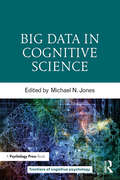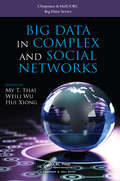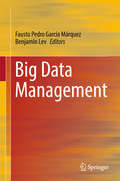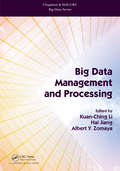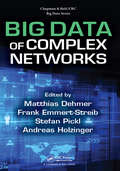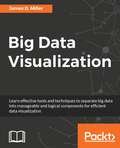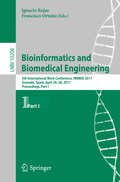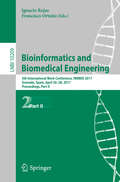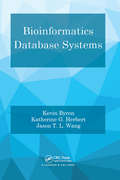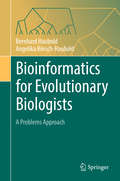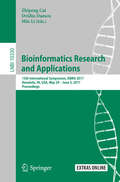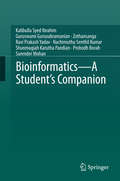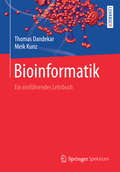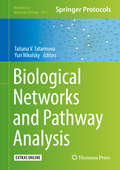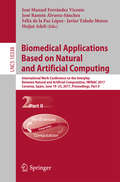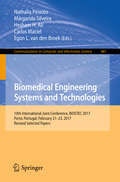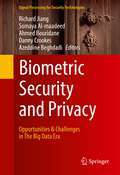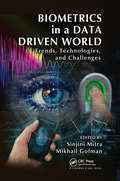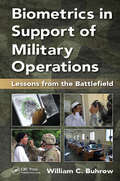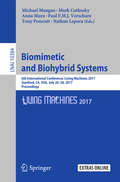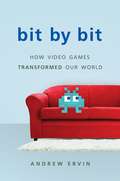- Table View
- List View
Big Data in Cognitive Science (Frontiers of Cognitive Psychology)
by Michael N. JonesWhile laboratory research is the backbone of collecting experimental data in cognitive science, a rapidly increasing amount of research is now capitalizing on large-scale and real-world digital data. Each piece of data is a trace of human behavior and offers us a potential clue to understanding basic cognitive principles. However, we have to be able to put the pieces together in a reasonable way, which necessitates both advances in our theoretical models and development of new methodological techniques. The primary goal of this volume is to present cutting-edge examples of mining large-scale and naturalistic data to discover important principles of cognition and evaluate theories that would not be possible without such a scale. This book also has a mission to stimulate cognitive scientists to consider new ways to harness big data in order to enhance our understanding of fundamental cognitive processes. Finally, this book aims to warn of the potential pitfalls of using, or being over-reliant on, big data and to show how big data can work alongside traditional, rigorously gathered experimental data rather than simply supersede it. In sum, this groundbreaking volume presents cognitive scientists and those in related fields with an exciting, detailed, stimulating, and realistic introduction to big data – and to show how it may greatly advance our understanding of the principles of human memory, perception, categorization, decision-making, language, problem-solving, and representation.
Big Data in Complex and Social Networks (Chapman & Hall/CRC Big Data Series)
by My T. Thai, Weili Wu, Hui XiongThis book presents recent developments on the theoretical, algorithmic, and application aspects of Big Data in Complex and Social Networks. The book consists of four parts, covering a wide range of topics. The first part of the book focuses on data storage and data processing. It explores how the efficient storage of data can fundamentally support intensive data access and queries, which enables sophisticated analysis. It also looks at how data processing and visualization help to communicate information clearly and efficiently. The second part of the book is devoted to the extraction of essential information and the prediction of web content. The book shows how Big Data analysis can be used to understand the interests, location, and search history of users and provide more accurate predictions of User Behavior. The latter two parts of the book cover the protection of privacy and security, and emergent applications of big data and social networks. It analyzes how to model rumor diffusion, identify misinformation from massive data, and design intervention strategies. Applications of big data and social networks in multilayer networks and multiparty systems are also covered in-depth.
Big Data Management
by Fausto Pedro García Márquez Benjamin LevThis book focuses on the analytic principles of business practice and big data. Specifically, it provides an interface between the main disciplines of engineering/technology and the organizational and administrative aspects of management, serving as a complement to books in other disciplines such as economics, finance, marketing and risk analysis. The contributors present their areas of expertise, together with essential case studies that illustrate the successful application of engineering management theories in real-life examples.
Big Data Management and Processing (Chapman & Hall/CRC Big Data Series)
by Kuan-Ching Li, Hai Jiang and Albert Y. ZomayaFrom the Foreword: "Big Data Management and Processing is [a] state-of-the-art book that deals with a wide range of topical themes in the field of Big Data. The book, which probes many issues related to this exciting and rapidly growing field, covers processing, management, analytics, and applications... [It] is a very valuable addition to the literature. It will serve as a source of up-to-date research in this continuously developing area. The book also provides an opportunity for researchers to explore the use of advanced computing technologies and their impact on enhancing our capabilities to conduct more sophisticated studies." ---Sartaj Sahni, University of Florida, USA "Big Data Management and Processing covers the latest Big Data research results in processing, analytics, management and applications. Both fundamental insights and representative applications are provided. This book is a timely and valuable resource for students, researchers and seasoned practitioners in Big Data fields. --Hai Jin, Huazhong University of Science and Technology, China Big Data Management and Processing explores a range of big data related issues and their impact on the design of new computing systems. The twenty-one chapters were carefully selected and feature contributions from several outstanding researchers. The book endeavors to strike a balance between theoretical and practical coverage of innovative problem solving techniques for a range of platforms. It serves as a repository of paradigms, technologies, and applications that target different facets of big data computing systems. The first part of the book explores energy and resource management issues, as well as legal compliance and quality management for Big Data. It covers In-Memory computing and In-Memory data grids, as well as co-scheduling for high performance computing applications. The second part of the book includes comprehensive coverage of Hadoop and Spark, along with security, privacy, and trust challenges and solutions. The latter part of the book covers mining and clustering in Big Data, and includes applications in genomics, hospital big data processing, and vehicular cloud computing. The book also analyzes funding for Big Data projects.
Big Data of Complex Networks (Chapman & Hall/CRC Big Data Series)
by Matthias Dehmer, Frank Emmert-Streib, Stefan Pickl and Andreas HolzingerBig Data of Complex Networks presents and explains the methods from the study of big data that can be used in analysing massive structural data sets, including both very large networks and sets of graphs. As well as applying statistical analysis techniques like sampling and bootstrapping in an interdisciplinary manner to produce novel techniques for analyzing massive amounts of data, this book also explores the possibilities offered by the special aspects such as computer memory in investigating large sets of complex networks. Intended for computer scientists, statisticians and mathematicians interested in the big data and networks, Big Data of Complex Networks is also a valuable tool for researchers in the fields of visualization, data analysis, computer vision and bioinformatics. Key features: Provides a complete discussion of both the hardware and software used to organize big data Describes a wide range of useful applications for managing big data and resultant data sets Maintains a firm focus on massive data and large networks Unveils innovative techniques to help readers handle big data Matthias Dehmer received his PhD in computer science from the Darmstadt University of Technology, Germany. Currently, he is Professor at UMIT – The Health and Life Sciences University, Austria, and the Universität der Bundeswehr München. His research interests are in graph theory, data science, complex networks, complexity, statistics and information theory. Frank Emmert-Streib received his PhD in theoretical physics from the University of Bremen, and is currently Associate professor at Tampere University of Technology, Finland. His research interests are in the field of computational biology, machine learning and network medicine. Stefan Pickl holds a PhD in mathematics from the Darmstadt University of Technology, and is currently a Professor at Bundeswehr Universität München. His research interests are in operations research, systems biology, graph theory and discrete optimization. Andreas Holzinger received his PhD in cognitive science from Graz University and his habilitation (second PhD) in computer science from Graz University of Technology. He is head of the Holzinger Group HCI-KDD at the Medical University Graz and Visiting Professor for Machine Learning in Health Informatics Vienna University of Technology.
Big Data Visualization
by James MillerThis book is for data analysts or those with a basic knowledge of big data analysis who want to learn big data visualization in order to make their analysis more useful. You need sufficient knowledge of big data platform tools such as Hadoop and also some experience with programming languages such as R. This book will be great for those who are familiar with conventional data visualizations and now want to widen their horizon by exploring big data visualizations.
Bioinformatics and Biomedical Engineering: 5th International Work-Conference, IWBBIO 2017, Granada, Spain, April 26–28, 2017, Proceedings, Part I (Lecture Notes in Computer Science #10208)
by Ignacio Rojas and Francisco OrtuñoThis two volume set LNBI 10208 and LNBI 10209 constitutes the proceedings of the 5th International Work-Conference on Bioinformatics and Biomedical Engineering, IWBBIO 2017, held in Granada, Spain, in April 2017. The 122 papers presented were carefully reviewed and selected from 309 submissions. The scope of the conference spans the following areas: advances in computational intelligence for critical care; bioinformatics for healthcare and diseases; biomedical engineering; biomedical image analysis; biomedical signal analysis; biomedicine; challenges representing large-scale biological data; computational genomics; computational proteomics; computational systems for modeling biological processes; data driven biology - new tools, techniques and resources; eHealth; high-throughput bioinformatic tools for genomics; oncological big data and new mathematical tools; smart sensor and sensor-network architectures; time lapse experiments and multivariate biostatistics.
Bioinformatics and Biomedical Engineering: 5th International Work-Conference, IWBBIO 2017, Granada, Spain, April 26–28, 2017, Proceedings, Part II (Lecture Notes in Computer Science #10209)
by Ignacio Rojas and Francisco OrtuñoThis two volume set LNBI 10208 and LNBI 10209 constitutes the proceedings of the 5th International Work-Conference on Bioinformatics and Biomedical Engineering, IWBBIO 2017, held in Granada, Spain, in April 2017. The 122 papers presented were carefully reviewed and selected from 309 submissions. The scope of the conference spans the following areas: advances in computational intelligence for critical care; bioinformatics for healthcare and diseases; biomedical engineering; biomedical image analysis; biomedical signal analysis; biomedicine; challenges representing large-scale biological data; computational genomics; computational proteomics; computational systems for modeling biological processes; data driven biology - new tools, techniques and resources; eHealth; high-throughput bioinformatic tools for genomics; oncological big data and new mathematical tools; smart sensor and sensor-network architectures; time lapse experiments and multivariate biostatistics.
Bioinformatics Database Systems
by Kevin Byron Katherine G. Herbert Jason T. WangModern biological databases comprise not only data, but also sophisticated query facilities and bioinformatics data analysis tools. This book provides an exploration through the world of Bioinformatics Database Systems. The book summarizes the popular and innovative bioinformatics repositories currently available, including popular primary genetic and protein sequence databases, phylogenetic databases, structure and pathway databases, microarray databases and boutique databases. It also explores the data quality and information integration issues currently involved with managing bioinformatics databases, including data quality issues that have been observed, and efforts in the data cleaning field. Biological data integration issues are also covered in-depth, and the book demonstrates how data integration can create new repositories to address the needs of the biological communities. It also presents typical data integration architectures employed in current bioinformatics databases. The latter part of the book covers biological data mining and biological data processing approaches using cloud-based technologies. General data mining approaches are discussed, as well as specific data mining methodologies that have been successfully deployed in biological data mining applications. Two biological data mining case studies are also included to illustrate how data, query, and analysis methods are integrated into user-friendly systems. Aimed at researchers and developers of bioinformatics database systems, the book is also useful as a supplementary textbook for a one-semester upper-level undergraduate course, or an introductory graduate bioinformatics course.
Bioinformatics for Evolutionary Biologists: A Problems Approach
by Bernhard Haubold Angelika Börsch-HauboldThis self-contained textbook covers fundamental aspects of sequence analysis in evolutionary biology, including sequence alignment, phylogeny reconstruction, and coalescent simulation. It addresses these aspects through a series of over 400 computer problems, ranging from elementary to research level to enable learning by doing. Students solve the problems in the same computational environment used for decades in science - the UNIX command line. This is available on all three major operating systems for PCs: Microsoft Windows, Mac-OSX, and Linux. To learn using this powerful system, students analyze sample sequence data by applying generic tools, bioinformatics software, and over 40 programs specifically written for this course. The solutions for all problems are included, making the book ideal for self-study. Problems are grouped into sections headed by an introduction and a list of new concepts and programs. By using practical computing to explore evolutionary concepts and sequence data, the book enables readers to tackle their own computational problems.
Bioinformatics Research and Applications: 13th International Symposium, ISBRA 2017, Honolulu, HI, USA, May 29 – June 2, 2017, Proceedings (Lecture Notes in Computer Science #10330)
by Zhipeng Cai, Ovidiu Daescu and Min LiThis book constitutes the proceedings of the 13th International Symposium on Bioinformatics Research and Applications, ISBRA 2017, held in Honolulu, HI, USA, in May/June 2017. The 27 full papers presented together with 18 short papers and 24 invited abstracts were carefully reviewed and selected from 131 submissions. They cover topics such as: biomarker discovery; biomedical databases and data integration; biomedical text mining and ortologies; biomolecular imaging; comparative genomics; computational genetic epidemiology; computational proteomics; data mining and visualization; gene expression analysis; genome analysis; high-performance bio-computing; metagenomics; molecular evolution; molecular modelling and simulation; next-generation sequencing data analysis; pattern discovery and classification; population genetics; software tools and applications; structural biology; and systems biology.
Bioinformatics - A Student's Companion
by Kalibulla Syed Ibrahim Guruswami Gurusubramanian Zothansanga Ravi Prakash Yadav Nachimuthu Senthil Kumar Shunmugiah Karutha Pandian Probodh Borah Surender MohanThis manual offers a stand-alone reading companion, unique in simplifying the practical components of Bioinformatics in a unique and user-friendly manner. It covers the practical component of syllabi used at most leading universities and discusses the most extensively used tools and methodologies in Bioinformatics. Research in the biological sciences has made tremendous strides in recent years due in part to the increased automation in data generation. At the same time, storing, managing and interpreting huge volumes of data has become one of the most challenging tasks for scientists. These two aspects have ultimately necessitated the application of computers, giving rise to a highly interdisciplinary discipline-Bioinformatics. Despite the richness of bioinformatics resources and methods, the exposure of life sciences undergraduates and postgraduates to bioinformatics is extremely limited. Though the internet offers various tools for free, and provides guides for using them, it fails to help users interpret the processed data. Moreover, most sites fail to update their help pages to accommodate software upgrades. Though the market is flooded with books discussing the theoretical concepts in Bioinformatics, a manual of this kind is rarely found. The content developed to meet the needs of readers from diverse background and to incorporate the syllabi of undergraduate and postgraduate courses at various universities.
Bioinformatik: Ein einführendes Lehrbuch
by Thomas Dandekar Meik KunzDieses Buch bietet eine packende Einf#65533;hrung in das am schnellsten wachsende Gebiet der Biologie mit leicht nachvollziehbaren Beispielen und einem gut aufbereitetem Anhang f#65533;r den Leser, der so gleich alles direkt nachkochen und miterleben kann. Das Buch holt den Leser bei den Grundlagen ab, wie man zum Beispiel Sequenzinformationen einfach erh#65533;lt und analysiert. In weiteren Kapiteln gehen die Autoren auf die verschiedenen Analysem#65533;glichkeiten von RNA, DNA und Proteinen bis hinzu ganzen Stoffwechselwegen ein. Dabei werden in jedem Kapitel spannende Beispiele aus der Biologie gew#65533;hlt, die zur Veranschaulichung der Analyse dienen. Jedes Kapitel wird mit einem #65533;bungsteil abgeschlossen, welches das Gelernte sogleich zur Anwendung bringt. Das Thema dieses Buches ist ein Muss f#65533;r jeden Biologiestudierenden, ob Bachelor- oder Masterstudium, da die Bioinformatik mittlerweile erstaunliche Einsichten in die molekularen Grundlagen aller Lebewesen zutage f#65533;rdert.
Biological Networks and Pathway Analysis (Methods in Molecular Biology #1613)
by Yuri Nikolsky Tatiana V. TatarinovaIn this volume, expert practitioners present a compilation of methods of functional data analysis (often referred to as "systems biology") and its applications in drug discovery, medicine, and basic disease research. It covers such important issues as the elucidation of protein, compound and gene interactions, as well as analytical tools, including networks, interactome and ontologies, and clinical applications of functional analysis. As a volume in the highly successful Methods in Molecular Biology series, this work provides detailed description and hands-on implementation advice. Reputable, comprehensive, and cutting-edge, Biological Networks and Pathway Analysis presents both "wet lab" experimental methods and computational tools in order to cover a broad spectrum of issues in this fascinating new field.
Biomedical Applications Based on Natural and Artificial Computing: International Work-Conference on the Interplay Between Natural and Artificial Computation, IWINAC 2017, Corunna, Spain, June 19-23, 2017, Proceedings, Part II (Lecture Notes in Computer Science #10338)
by Hojjat Adeli José Manuel Ferrández Vicente José Ramón Álvarez-Sánchez Félix de la Paz López Javier Toledo MoreoThe two volumes LNCS 10337 and 10338 constitute the proceedings of the International Work-Conference on the Interplay Between Natural and Artificial Computation, IWINAC 2017, held in Corunna, Spain, in June 2017. The total of 102 full papers was carefully reviewed and selected from 194 submissions during two rounds of reviewing and improvement. The papers are organized in two volumes, one on natural and artificial computation for biomedicine and neuroscience, addressing topics such as theoretical neural computation; models; natural computing in bioinformatics; physiological computing in affective smart environments; emotions; as well as signal processing and machine learning applied to biomedical and neuroscience applications. The second volume deals with biomedical applications, based on natural and artificial computing and addresses topics such as biomedical applications; mobile brain computer interaction; human robot interaction; deep learning; machine learning applied to big data analysis; computational intelligence in data coding and transmission; and applications.
Biomedical Engineering Systems and Technologies: 10th International Joint Conference, Biostec 2017, Porto, Portugal, February 21-23, 2017, Revised Selected Papers (Communications In Computer And Information Science #881)
by Egon L. van den Broek Carlos Maciel Hesham H. Ali Margarida Silveira Nathalia PeixotoThis book constitutes the thoroughly refereed post-conference proceedings of the 10th International Joint Conference on Biomedical Engineering Systems and Technologies, BIOSTEC 2017, held in Porto, Portugal, in February 2017.The 20 revised full papers presented were carefully reviewed and selected from a total of 297 submissions. The papers are organized in topical sections on biomedical electronics and devices; bioimaging; bioinformatics models, methods and algorithms; bio-inspired systems and signal processing; and health informatics.
Biometric Security and Privacy: Opportunities & Challenges in The Big Data Era (Signal Processing for Security Technologies)
by Richard Jiang Somaya Al-Maadeed Ahmed Bouridane Danny Crookes Azeddine BeghdadiThis book highlights recent research advances on biometrics using new methods such as deep learning, nonlinear graph embedding, fuzzy approaches, and ensemble learning. Included are special biometric technologies related to privacy and security issues, such as cancellable biometrics and soft biometrics. The book also focuses on several emerging topics such as big data issues, internet of things, medical biometrics, healthcare, and robot-human interactions. The authors show how these new applications have triggered a number of new biometric approaches. They show, as an example, how fuzzy extractor has become a useful tool for key generation in biometric banking, and vein/heart rates from medical records can also be used to identify patients. The contributors cover the topics, their methods, and their applications in depth.
Biometrics in a Data Driven World: Trends, Technologies, and Challenges
by Sinjini Mitra and Mikhail GofmanBiometrics in a Data Driven World: Trends, Technologies, and Challenges aims to inform readers about the modern applications of biometrics in the context of a data-driven society, to familiarize them with the rich history of biometrics, and to provide them with a glimpse into the future of biometrics. The first section of the book discusses the fundamentals of biometrics and provides an overview of common biometric modalities, namely face, fingerprints, iris, and voice. It also discusses the history of the field, and provides an overview of emerging trends and opportunities. The second section of the book introduces readers to a wide range of biometric applications. The next part of the book is dedicated to the discussion of case studies of biometric modalities currently used on mobile applications. As smartphones and tablet computers are rapidly becoming the dominant consumer computer platforms, biometrics-based authentication is emerging as an integral part of protecting mobile devices against unauthorized access, while enabling new and highly popular applications, such as secure online payment authorization. The book concludes with a discussion of future trends and opportunities in the field of biometrics, which will pave the way for advancing research in the area of biometrics, and for the deployment of biometric technologies in real-world applications. The book is designed for individuals interested in exploring the contemporary applications of biometrics, from students to researchers and practitioners working in this field. Both undergraduate and graduate students enrolled in college-level security courses will also find this book to be an especially useful companion.
Biometrics in Support of Military Operations: Lessons from the Battlefield
by William C. BuhrowBiometrics in Support of Military Operations: Lessons from the Battlefield examines and evaluates recent U.S. military experiences in Iraq and Afghanistan in the context of the use of biometrics and related technologies. The book takes a comprehensive look at how biometrics has been used to support various military operations and suggests ways that its uses can be further developed. It fills a void in understanding how to incorporate biometrics by providing a guide to develop and establish formal operational roles and procedures when applying the technology. Written in an informal style that makes it accessible to people who are not necessarily operators or technicians of biometrics technologies, this book bridges an existing gap to better educate leaders inside and outside of the U.S. military on the far-reaching potential of biometrics in support of tactical operations. It argues that the gap between those inside and outside the military is the result of failure to document lessons learned from battle experience, as well as a lack of a combined vision among the Joint Forces to fully recognize and exploit the capabilities of biometrics for enhanced future success. This book fills that gap. Biometrics has great potential as an effective tool if properly developed and utilized. The book concludes with a look at the future of emerging applications for the military but also considers a wider range of deployment of biometrics outside the military, such as in governmental organizations, including foreign diplomacy. Biometrics can be applied to any operational area that requires accurate and rapid identification of unknown individuals in order to support its operations and protect personnel and resources. Biometrics in Support of Military Operations is an important beginning point in an emerging field for gaining understanding and better mastery of biometrics.
Biomimetic and Biohybrid Systems: 6th International Conference, Living Machines 2017, Stanford, CA, USA, July 26–28, 2017, Proceedings (Lecture Notes in Computer Science #10384)
by Michael Mangan, Mark Cutkosky, Anna Mura, Paul F.M.J. Verschure, Tony Prescott and Nathan LeporaThis book constitutes the proceedings of the 6th International Conference on Biomimetic and Biohybrid Systems, Living Machines 2017, held in Stanford, CA, USA, in July 2017.The 42 full and 19 short papers presented in this volume were carefully reviewed and selected from 63 submissions. The theme of the conference encompasses biomimetic methods for manufacture, repair and recycling inspired by natural processes such as reproduction, digestion, morphogenesis and metamorphosis.
Bit by Bit: How Video Games Transformed Our World
by Andrew ErvinAn acclaimed novelist and critic argues that video games are the most vital art form of our timeVideo games have been around for decades, but only in recent years have they gone truly mainstream. Today, the majority of American households play video games, almost half of gamers are women, and professional video game tournaments attract more viewers than the World Series. Yet we still don't take games seriously, preferring to see them as little more than entertaining diversions, a means of making the commute go by a little more quickly.In Bit by Bit, a blend of history, memoir, and reportage, Andrew Ervin sets out to understand the explosive popularity of this often maligned cultural form. He travels to government laboratories, junk shops, and art museums. He scientists and hobbyists, critics and game makers. He installs a full-sized and obscenely loud Donkey Kong arcade cabinet in his basement, and plays enough Minecraft to suffer from "Minecraft syndrome," the effect of seeing objects in real life as poorly rendered blocks.In exploring the material, technological, and business history of video games, from Tennis for Two (1958) to Pokemon Go and beyond, Ervin shows how games constitute a unique storytelling medium that offers us startling new ways to think about our lives and the world around us. And he argues that the best games, as defined by the aesthetic and even political ambitions of their creators, rise to the level of art. In this witty, searching book, Ervin explains the immense power of games--and why their reign will be long.
Bitcoin: Introducción simple
by Esteban Lanza Ortega Eric MorseComprende los fundamentos de Bitcoin. Bitcoin es una revolucionaria divisa digital que está transformando el concepto de dinero que conocemos. Pero su comprensión puede ser intimidante para el usuario medio. ¡A partir de ahora dejará de serlo! Este libro elimina esta complejidad y enseña los fundamentos de Bitcoin de manera simple, con un lenguaje fácil de entender. No es un libro de texto. Es un primer contacto que responde a las más importantes y comunes preguntas que los nuevos usuarios tienen sobre Bitcoin. Sin jerga, sin tecnicismos y sin requerir conocimientos previos. En este libro encontrarás respuestas a preguntas como: ¿Qué es Bitcoin? ¿Qué lo hace tan especial? ¿Qué es el Blockchain? ¿Qué es la minería? ¿Quién controla Bitcoin? ¿Es Bitcoin seguro? ¿Es Bitcoin anónimo? ¿Cómo puedo usarlo de manera segura? ¿Debería invertir en Bitcoin? ¡…Y mucho más! ¡Y con este libro no te sentirás como si te estuvieran enseñando una lengua extranjera o un grado en ciencias de la computación! Prerrequisitos: ¡NINGUNO! Si alguna vez has comprado algo online, ya tienes lo que se necesita para entender este libro y aprender los fundamentos de Bitcoin.
Bitcoin: Uma Introdução Simples
by Eric Morse João Rossi ParreirasA Bitcoin é uma moeda digital revolucionária que está mudando o dinheiro como o conhecemos, mas entendê-la pode ser um pouco assustador para o usuário novato. Não é mais! Este livro se despe de toda a complexidade e ensina o básico da Bitcoin em uma linguagem simples e fácil de entender. Este livro não é um livro didático. Ele é um guia para iniciantes que responde as perguntas mais comuns e importantes que novos usuários têm sobre a Bitcoin. Sem jargões. Sem tecnicalidades. Sem nenhum conhecimento técnico prévio necessário. As respostas que encontrará neste livro: O que é a Bitcoin? O que faz dela especial? O que é a Blockchain? O que é mineração? Quem controla a Bitcoin? A Bitcoin é segura? A Bitcoin é anônima? Como posso utilizar a Bitcoin com segurança? Eu devo investir em Bitcoins? ...E Mais! E você não se sentirá aprendendo um novo idioma ou obtendo um diploma em tecnologia da informação! Pré-requisitos: NENHUM! Se você alguma vez já comprou algo pela internet, você já sabe o necessário para entender este livro e aprender o básico sobre a Bitcoin.
Bitcoin: Een eenvoudige introductie
by Eric Morse Anne Van GulickBitcoin is een revolutionaire digitale valuta die de manier waarop we over geld denken verandert, maar de complexiteit ervan kan ontmoedigend zijn voor de gemiddelde gebruiker. Maar nu niet meer! Dit boek rekent af met de complexiteit en legt de basis van Bitcoin uit in eenvoudige taal. Het is geen lesboek, maar een niet-technische inleiding die de meest voorkomende en belangrijkste vragen die beginnende gebruikers over Bitcoin hebben beantwoordt. Geen jargon, geen technobabble en geen technische voorkennis vereist. De volgende vragen worden beantwoord in het boek: Wat is Bitcoin? Waarom is het zo bijzonder? Wat is de blokketen? Wat is mining? Wie heeft de controle over Bitcoin? Is Bitcoin veilig? Is Bitcoin anoniem? Hoe kan ik Bitcoin veilig gebruiken? Is het een goed idee om te investeren in Bitcoin? ... en meer! Je zult niet het gevoel krijgen dat je een andere taal aan het leren bent of een studie computerwetenschappen aan het doen bent! Vereiste voorkennis: geen! Als je ooit eerder iets online gekocht hebt, weet je alles al wat nodig is om dit boek te begrijpen en de basis van Bitcoin te leren.
Bitcoin per tutti
by Eric Morse F. RossiCapire le basi dei Bitcoin I bitcoin sono una valuta digitale rivoluzionaria che sta trasformando il denaro come lo conosciamo, ma capire come funzionano può essere difficoltoso per un utente medio. Ora non più! Questo libro mette da parte le complessità e insegna le basi dei Bitcoin in modo semplice e comprensibile. Non è un libro di testo, ma un manuale introduttivo non tecnico che risponde alle domande più comuni e importanti che gli utenti hanno sui bitcoin, senza usare tecnicismi e senza aver bisogno di conoscenze tecniche pregresse. In questo libro troverete le risposte a: Cosa sono i Bitcoin? Cos’hanno di speciale? Cosa è la Blockchain? Cos’è il Mining? Chi controlla i Bitcoin? I Bitcoin sono sicuri? I Bitcoin sono anonimi? Come posso usarli in sicurezza? Devo investirci? ...e molto altro! E non vi sentirete come se steste imparando un'altra lingua o studiando per una laurea in informatica! Prerequisiti: NESSUNO! Se avete comprato qualcosa online sapete tutto ciò che serve per capire questo libro e imparare le basi di Bitcoin.
